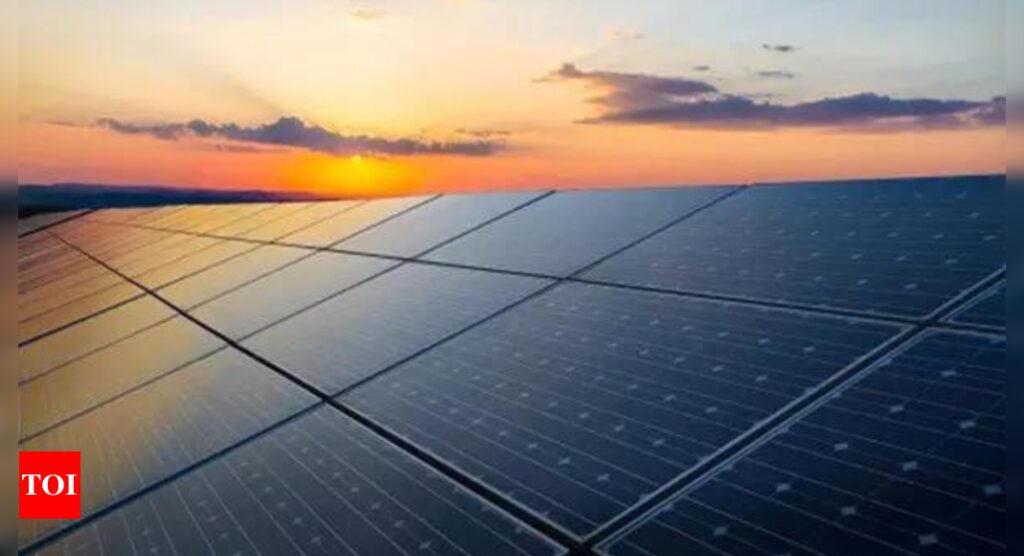[ad_1]
LEH: The government on Wednesday approved construction of 713-km transmission line at an investment of Rs 20,773 crore for wheeling electricity from a 13 gigawatts (GW) solar power-cum-12 GW-hour battery storage project proposed to be built in Ladakh, first reported by TOI on January 13, 2019.
According to the decision taken by the Cabinet’s panel on economic matters, the Centre will provide viability gap funding of Rs 8,309 crore, or 40% of the project cost, to keep transmission tariff affordable.
The approval also includes building of an interconnect to link for feeding power from the project into the grid in Leh. The project, to be built at Pang, a vast wind-swept plateau 174 kms southeast of Ladakh’s capital Leh along the road to Manali, will also be connected to Leh-Kargil-Alusteng-Srinagar line for powering up Kargil and Jammu & Kashmir.
The high voltage direct current line has been accorded the status of a ‘national project’ and state-run transmission utility PowerGrid has been tasked to build it without bidding. The link with a capacity of 5 GW will plug into the national grid at the Kaithal, 186 km north of Delhi, in Haryana after crossing Himachal Pradesh and Punjab.
The transmission line would be a global engineering marvel as it will have to be built across stratospheric mountains and will test the limits of endurance both of men and machines due to rarefied atmosphere as well as extreme weather fluctuating between 40 degrees in summer and minus 40 degrees combined with wind chill during long winter.
Addressing the nation on abrogation of Article 370 of the Constitution, which turned Ladakh into a federal territory, prime minister Narendra Modi had on August 8, 2019 flagged projects to tap solar energy potential as a key engine of growth for the region. In his Independence Day speech next year, he announced construction of a 7.5 GW solar park in Ladakh, which has now been scaled up.
The original plan was to build a 5 GW solar project at Nyoma, close to the LAC, and another 2.5 GW plant in Kargil. But the plan for Nyoma fell foul of the wildlife department and the project was relocated to Pang with higher capacity. The Kargil project was spiked due to difficult geography.
In its current form, the Pang project will help achieve the target of 500 GW of non-fossil fuel generation capacity 2030. The project will generate large direct and indirect employment opportunities for both skilled and unskilled personnel in power and other related fields.
According to the decision taken by the Cabinet’s panel on economic matters, the Centre will provide viability gap funding of Rs 8,309 crore, or 40% of the project cost, to keep transmission tariff affordable.
The approval also includes building of an interconnect to link for feeding power from the project into the grid in Leh. The project, to be built at Pang, a vast wind-swept plateau 174 kms southeast of Ladakh’s capital Leh along the road to Manali, will also be connected to Leh-Kargil-Alusteng-Srinagar line for powering up Kargil and Jammu & Kashmir.
The high voltage direct current line has been accorded the status of a ‘national project’ and state-run transmission utility PowerGrid has been tasked to build it without bidding. The link with a capacity of 5 GW will plug into the national grid at the Kaithal, 186 km north of Delhi, in Haryana after crossing Himachal Pradesh and Punjab.
The transmission line would be a global engineering marvel as it will have to be built across stratospheric mountains and will test the limits of endurance both of men and machines due to rarefied atmosphere as well as extreme weather fluctuating between 40 degrees in summer and minus 40 degrees combined with wind chill during long winter.
Addressing the nation on abrogation of Article 370 of the Constitution, which turned Ladakh into a federal territory, prime minister Narendra Modi had on August 8, 2019 flagged projects to tap solar energy potential as a key engine of growth for the region. In his Independence Day speech next year, he announced construction of a 7.5 GW solar park in Ladakh, which has now been scaled up.
The original plan was to build a 5 GW solar project at Nyoma, close to the LAC, and another 2.5 GW plant in Kargil. But the plan for Nyoma fell foul of the wildlife department and the project was relocated to Pang with higher capacity. The Kargil project was spiked due to difficult geography.
In its current form, the Pang project will help achieve the target of 500 GW of non-fossil fuel generation capacity 2030. The project will generate large direct and indirect employment opportunities for both skilled and unskilled personnel in power and other related fields.
[ad_2]
Source link











More Stories
India’S Growth Forecast: S&P ups India’s FY’24 growth forecast to 6.4% on robust domestic momentum
India to remain fastest-growing major economy, but demand uneven: Poll
Jack Ma: Jack Ma gets back into business with ‘Ma’s Kitchen Food’